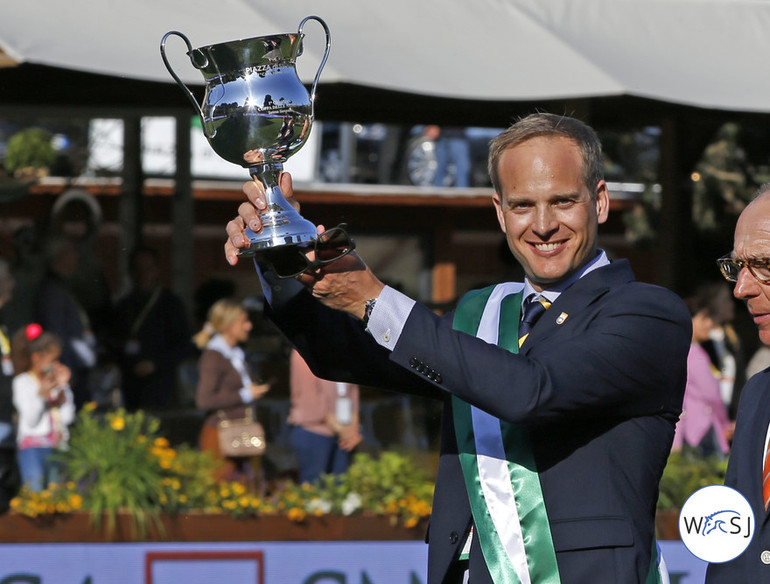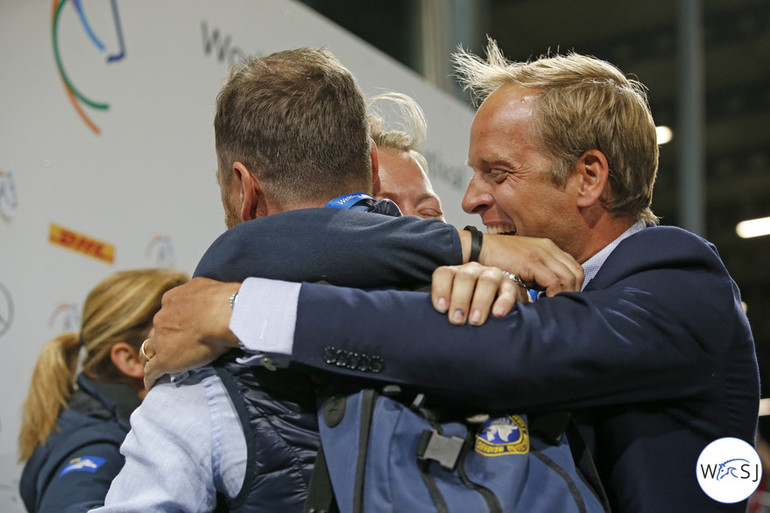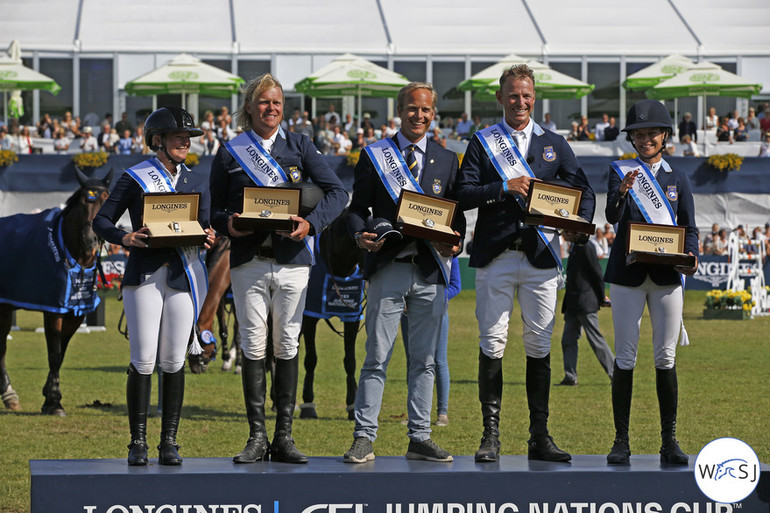Text © World of Showjumping by Nanna Nieminen
Team Sweden has been on a winning streak this summer, with back-to-back Nations Cup victories in Rome, Falsterbo, Aachen and more recently at Hickstead. After the Swedish win in Aachen, WoSJ sat down with their Chef d’Equipe Henrik Ankarcrona to discuss team dynamics, his thoughts on leadership and the challenge of bringing different individuals together.
Ankarcrona has been Chef d’Equipe for Team Sweden for nearly three years. Compared to many of his colleagues, Ankarcrona is still relatively new to his role and he believes the seeds for today’s success were sowed a long time ago. “We’ve had this tremendous success now, and it is a result of many good decisions made in the past,” he explains. “We have had a period in Sweden where we have been bringing up new riders as well as horses. Also, some of our riders realized that they need to go abroad to learn more about the sport and the right management. We have created some really strong relationships with horse owners, we have built good competitions – we have all of this,” he says. “And this is the base.”
Building from this, Ankarcrona’s job has included finding the right team members for each selection and each venue. “To be able to put that together and come up with good teams, that has been my challenge,” he tells. “And not only to bring out a good team, but to create an environment where the riders like to be on the team and where they will help each other,” he continues. To top it all off, a little dose of luck never hurts. “You need luck to win. In this sport, sometimes it works out and sometimes it doesn’t. As a leader, I have never been part of anything bigger than winning in Aachen. I am sure when we are old, we are going to talk about that week. I am going to be proud until I am ten feet under.”
“But that comes later,” Ankarcrona says. Because for now, he is busy building for more. How exactly is Ankarcrona constructing his work, we ask? “I am trying to be close to the riders, and to communicate,” he answers. “I am for sure not trying to be their trainer. I am trying to be someone they can ask questions, someone they can rely on – the guy in the middle. I am always trying to be there for them.”
“I think this sport is a lot about confidence,” Ankarcrona continues to explain about his philosophy. “If the riders have confidence in me, if they know that I will do my best to put together a good team, then I believe they are also all in. I believe it is important to have a small group of leaders, who are close to the riders.”
To lead a group of top individual athletes is always a challenge, not to mention a group where half of these athletes are living animals with a mind of their own. As a Chef d’Equipe, Ankarcrona has been given one of the most demanding jobs in the industry. “It is about creating an environment where they all can perform,” he tells about the core of his commitment. “They have to trust the group. Trust that everyone comes into the team with a good horse, and are ready to go.”
Many other teams have trainers traveling with them, but not the Swedes. “I am not saying that it is negative to have one. However, at the moment, I would like the riders to help each other,” Ankarcrona explains. “There is no one more loyal than the small group itself, and with the fantastic riders we have in our team and with their endless thrive to improve, we can already do a lot. With riders like Henrik (von Eckermann), Peder (Fredricson), Malin (Baryard-Johnsson), Rolf-Göran (Bengtsson) – if we really can use their knowledge together, we can be strong. It is an individual sport, but if a team can come together and really fight for each other, I am sure that gives that couple of hundreds of seconds on the right spot, it keeps that one fence up – at least I believe so. Not all the time, because you win, and you lose, and not directly, but indirectly.”
From day to day, what does Ankarcrona’s work routines look like? “It is a complex job, with a lot of planning,” he starts. “At the show itself, you should do as little as possible, to be honest. I am just always there, with the information the riders might need. I am not there to teach anyone anything. There is so much experience within the team, it is my job to get it out of them and to pass it on in the group. That is part of our success.”
“The margin between success and failure is so small,” Henrik says when we move on to speak about the other side of the medal. “It is easy to sit here, and to claim that I know how it works now. But I don’t!” he says. “I am trying to work with what we have. I am trying to do my best, and I would like to believe this is contagious and it spreads in the group. A little misunderstanding can easily turn into a huge thing. There is so much pressure on the riders, they all have different responsibilities to their horse owners, sponsors, their own teams and families – and I have to understand all of them. Also, I have to make the other riders on the team understand this. They might think one of the riders made a bad choice, but they might also not know all the circumstances. Again, my job is to make sure everything works smooth and that everyone is informed.”
Ankarcrona is full of energy and hope for the future. “I keep looking to the other Chef d’Equipes and ask them questions, they have so much experience,” he tells. “We need to see the long road ahead of us. I want to see the horses and riders grow into their full potential. To be able to help them in this by putting them at the right shows and planning long-term, that already feels like success. Those tools I can use, but the riders need to do the job themselves.”
“I always want to believe that whatever plan we make for the team, also will be the best for that individual horse-and-rider combination moving forward. Horses should be stronger after the show than they were before. They can be physically tired, but mentally they should develop. The motion forward is what I really believe is the best part of the job. That is the beauty of it, more than any result.”
No reproduction without permission, copyright © World of Showjumping











